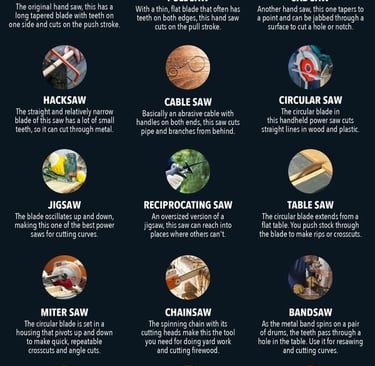Comprehensive Guide to Different Types of Saws and Their Uses
Saws are essential tools in woodworking, metalworking, and various DIY projects.
ARTICLES
12/31/20242 min read


Understanding the differences between saw types helps ensure the right tool is used for the task at hand. Here’s a detailed guide to some of the most common saws and their applications:
1. Rip Saw
• Use: Designed for hand-cutting wood along the grain.
• Features: A long, tapered blade with teeth that cut on the push stroke.
• Ideal for: Making straight cuts in wood planks.
2. Pull Saw
• Use: A hand saw that cuts on the pull stroke.
• Features: Thin, flat blade with teeth on both edges for precise cutting.
• Ideal for: Fine woodworking tasks requiring clean cuts.
3. Jab Saw
• Use: To create holes or notches in materials.
• Features: Pointed blade for easy penetration.
• Ideal for: Drywall and plasterboard cutting.
4. Hacksaw
• Use: Cutting metal and plastic.
• Features: Narrow blade with small teeth.
• Ideal for: Pipes, rods, and light metals.
5. Cable Saw
• Use: Cutting pipes and branches in hard-to-reach areas.
• Features: Abrasive cable with handles on both ends.
• Ideal for: Flexible and precise cutting of non-rigid materials.
6. Circular Saw
• Use: Straight-line cuts in wood and plastic.
• Features: A circular blade powered by a handheld tool.
• Ideal for: Quick, efficient cuts in larger materials.
7. Jigsaw
• Use: Making intricate or curved cuts.
• Features: Blade oscillates up and down.
• Ideal for: Creative projects like designing furniture or art.
8. Reciprocating Saw
• Use: Cutting in tight or awkward spaces.
• Features: A large version of a jigsaw with powerful oscillation.
• Ideal for: Demolition tasks and pruning.
9. Table Saw
• Use: Ripping wood into smaller pieces.
• Features: Blade protrudes from a table, cutting as material is pushed through.
• Ideal for: Precise, repeatable cuts in woodworking.
10. Miter Saw
• Use: Crosscuts and angled cuts.
• Features: Circular blade pivots for exact angles.
• Ideal for: Framing and trim work.
11. Chainsaw
• Use: Heavy-duty cutting tasks.
• Features: Rotating chain with cutting teeth.
• Ideal for: Yard work and cutting firewood.
12. Bandsaw
• Use: Cutting curves and resawing.
• Features: Continuous metal blade on two drums.
• Ideal for: Thick wood or intricate shapes.
13. Hole Saw
• Use: Creating precise circular holes.
• Features: Drill-attached tool with circular cutting teeth.
• Ideal for: Door lock installation and pipe holes.
14. Rotary Saw
• Use: Freehand cutting in various materials.
• Features: Drill-bit-like blade for cutting complex shapes.
• Ideal for: Drywall and plastic.
15. Oscillating Saw
• Use: Versatile tool for flush cuts and demolition.
• Features: Oscillates back and forth.
• Ideal for: Undercutting doors and removing old grout.
Choosing the Right Saw
The right saw depends on the material, precision, and type of cut required. Selecting the correct tool ensures efficiency, safety, and the best results for your project.
Contact Us for Your Projects!
If you need assistance with your construction, remodeling, or DIY projects, we’re here to help.
📞 Phone: 818-401-7766
📧 Email: info@prohandshandyman.com
🌐 Website: www.prohandshandyman.com
We offer services in Glendale, Burbank, Pasadena, and surrounding areas. Let’s turn your vision into reality!
